
Steamboat Waybills, page 12
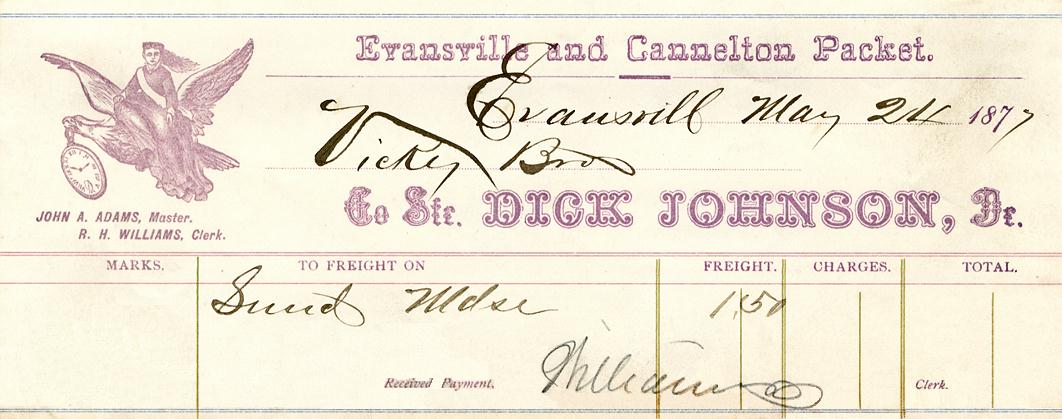
Way's Packet Directory 1548
DICK JOHNSON unknown rig. Likely a sternwheeler . . .
Built at Evansville, Indiana in 1871
217 tons.
Built as a low water boat for the Evansville Cairo trade under the command of Capt. Lee Howell.
Ran Evansville-Cannelton in 1875 under Capt. Robert C . Adams, with John A. Adams, clerk.
Same trade in 1877 under Capt. John A. Williams, with R. H. Williams, clerk. (The names of both these gentlemen are printed on this waybill from that year and Mr. Williams signed it in pencil on the bottom at Evansville, Indiana).
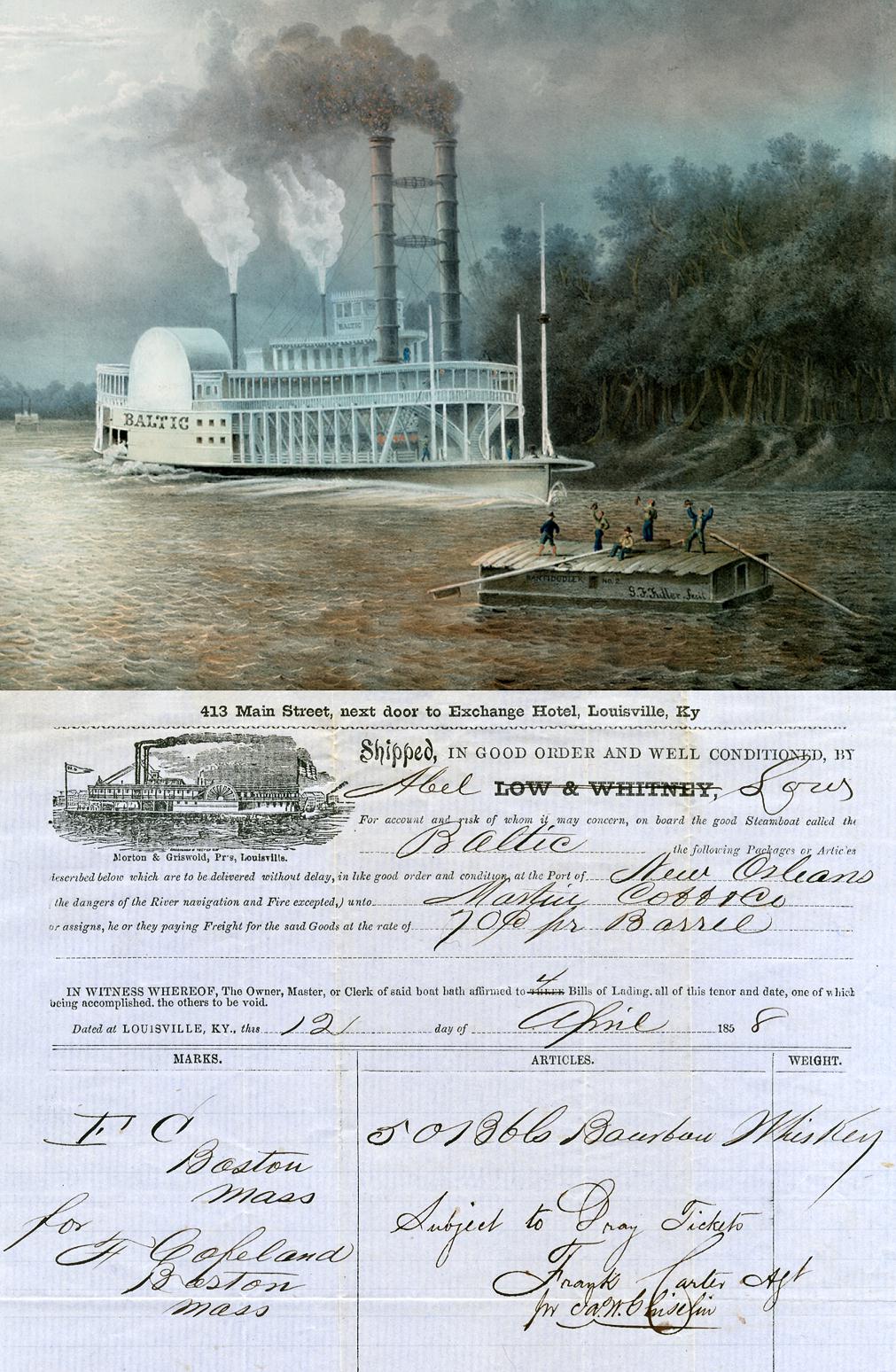
Original waybill in my collection from the BALTIC dated 12 April 1858 under a detail from a lithograph engraved by A. Weingartner in New York in 1859 from a painting by George F. Fuller (1822-1884) of the race between the BALTIC and the DIANA which took place in March, 1858 The BALTIC was the winner of the race, arriving on March 25, 1858 in Louisville, 18 days prior to the writing of this waybill. The DIANA arrived at Louisville one hour and 45 minutes after the BALTIC. An appreciation of the painting and lithograph is included in Fred Way's profile of the BALTIC below.
We have a file of the full lithograph on Illustrations, page 7.
BALTIC sidewheel packet
Way's Packet Directory Number 0437
Built at New Albany, Ind., 1857
250 x 37 x 7.
Engines, 26's- 9 ft. Five boilers.
Principally owned by Capt. C . H. Meekin, New Albany, who was master.
Head clerk was George P. Jouett, late of the A. L. SHOTWELL.
Ran Louisville-New Orleans.
Ran a race with the DIANA all the way from New Orleans to Louisville in March 1858, a classic of the rivers.
On Sunday, Mar. 21, 1858, these two boats left New Orleans within two minutes of one another.
At Point Worthington they locked horns and ran together some fifteen miles.
The first three nights were cloudy and very dark after the moon went down and shifting fogs before daylight.
There was a strong rise out of the Arkansas River to fight, and then a rise in the Mississippi with heavy drift running, and the Ohio River was rising all the way to Louisville.
The BALTIC arrived at the foot of Third St., Louisville, at 11:12 P.M. Thursday, March 25.
Time: five days six hours twenty-two minutes. She was declared the winner.
The DIANA came up in five days eight hours seven minutes.
The race was widely watched inasmuch as the contestants were in sight of one another a great part of the way, in this respect undoubtedly the longest and most animated race ever run on the Mississippi System.
An oil painting of the event gained wide acclaim.
Said the Louisville Journal on Feb. 9, 1860: "A fine painting by Mr. George F. Fuller, descriptive of the trial of speed between the BALTIC and DIANA has been lithographed by Weingartner, one of the best artists in the country, for M. Knoedler of New York and the London and Parisian publishing houses of Goupel & Co.
Our citizens had an opportunity of inspecting this picture last year when it elicited much praise for the spirit of its delineation, the truth of its coloring and the admirable disposition of its details.
It is a moonlight scene, the rival boats under full head of steam, and the waters lurid with-the glare of fires, while busy hands are engaged in cramming the furnaces with combustibles.
Each of the steamers takes a sheer to avoid a flatboat, which is lazily drifting down with the current, while the boatmen are all excited at the race.
There is fine repose in the scenery which contrasts forcibly with the action portrayed, and the whole forms one of the most characteristic Western pictures we have ever seen.
Mr. Fuller has achieved several successes and we are glad to see his picture reproduced by lithograph and so handsomely colored.
The Gouples will introduce it to the European connoisseurs, and we have no doubt it will bring forth fame and profit to the artist."
The BALTIC was acquired by the Unite States Quartermasters Department during the Civil War and served with Admiral David Dixon Porter on the Red River in 1864.
Was said to have made a trip to Mobile as a transport later.
Sold back to private hands in 1866.
Last owner was William M. McPherson, St. Louis.
Capt. Patrick Yore took her there, and she was dismantled.
Engines went to BISMARCK in 1867.
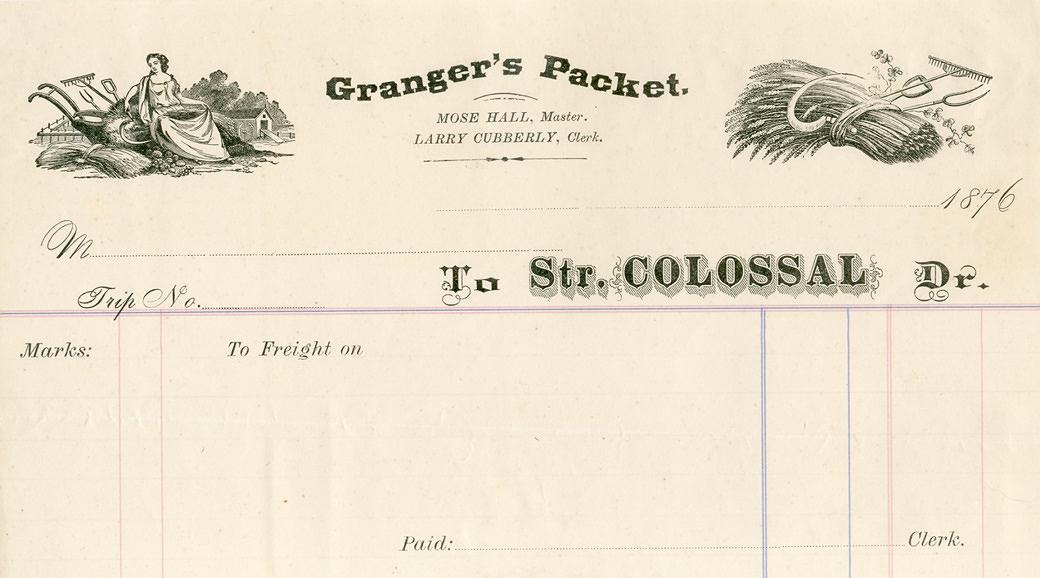
Unusual waybill, the only one I have that was never filled out. A Spartan boat with no passenger cabin, if there was a "texas" under the pilot house on the hurricane roof the officers and some crew would have slept and eaten up there.
Printed date 1876, the year the COLOSSAL was lost to fire at St. Louis. Possible that this waybill was among a bunch that were still at the printers where they hadn't got around to delivering them to the boat.
"Granger's Packet" and the agricultural themed vignettes suggests that the Granger's was a co-operative at St. Louis that ran granaries on the waterfront where local farm produce like wheat was kept prior to being shipped by steamboat downriver to New Orleans. The COLOSSAL was probably bought by the Grangers to haul grain exclusively rather than having to hire a towboat and barges for the purpose. Mose Hall, Master and Larry Cubberly, Clerk sound like they were a colorful pair of galoots.
en.wikipedia.org
In France a Granger was a farm bailiff who oversaw the collection of rent and taxes from the barns and storehouses of the lord of the manor. The Officer's Anglo-Norman title was grainger, and Old French grangier, which are both derived from the Late Latin granicarius (a derivative of granica, meaning "granary").
COLOSSAL sternwheel packet boat
Way's Packet Directory Number 1239
Built at Pittsburgh, Pa., 1869.
185 x 36 x 8. Owned by M.A. Cox, Adam Jacobs, and others.
Primarily a heavy freight carrier, and came out now with no passenger cabin.
Sold May 1870 by Capt. Cox to Little Rock Railroad for transporting iron and other railroad material.
Went to U.S. marshal sale at New Orleans in spring 1871, sold to Memphis & El Paso RR.
Later was bought by A.B. Hall, Willard Blakeslee, and others, St. Louis.
She was at Cincinnati from St. Louis, August 1873 with iron ore, and thence to Pittsburgh to load railroad iron for the Iron Mountain Railroad in barges.
Burned at St. Louis, Mar. 8, 1876.
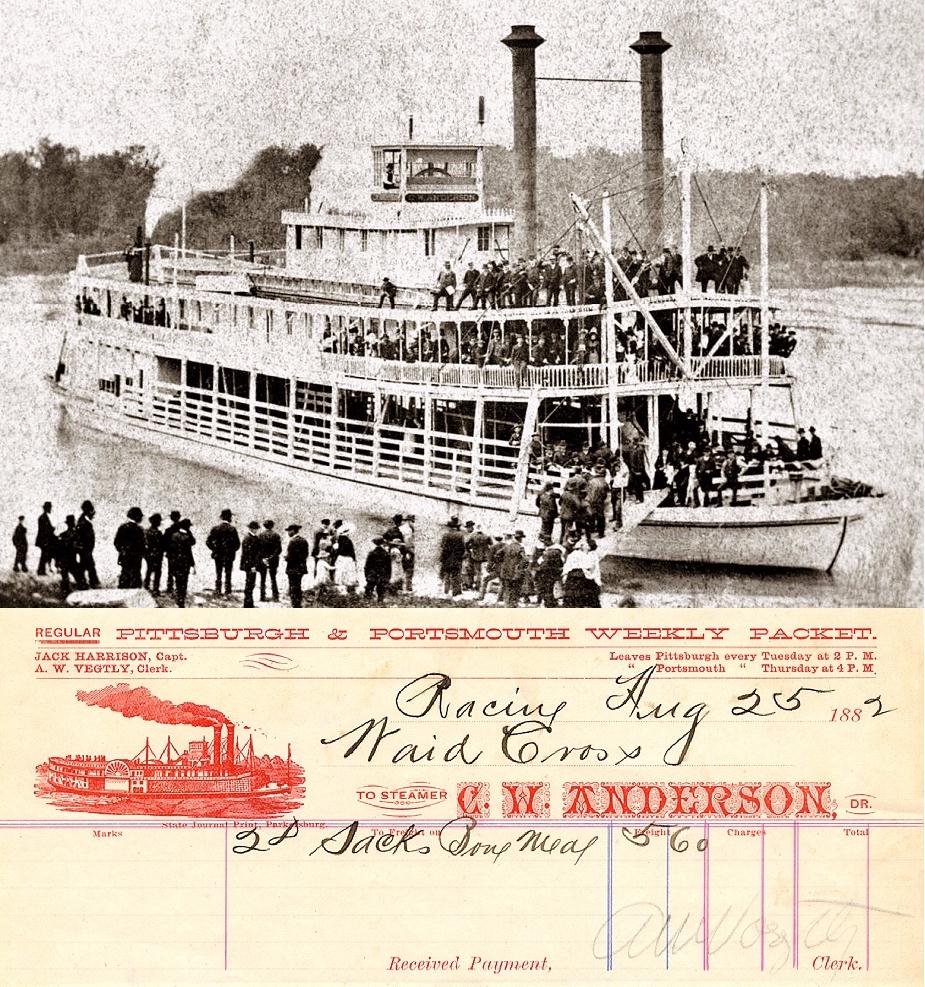
C.W. ANDERSON
Way's Packet Directory Number 0777
Sternwheeler built at Jeffersonville, Indiana by Howard in1876.
161 x 31.8 x 4.8.
Much equipment from the BERMUDA (1864-1876) was used in building.
Named for an old Cincinnati merchant who was Chief of Staff under Confederate General Nathan Bedford Forrest. Former river skipper Capt. Tom Ryman ran her on the Cumberland River.
Sold 1882 to Capt. Jack Harrison, Belpre, Ohio, who, with A.W. Voegtly, clerk, ran her in the Pittsburgh-Portsmouth trade, culminating in hitting the K&M bridge, Point Pleasant, W Va., and sinking her.
Capt. Sol York took her to the Illinois River 1884 and sold her in 1885 to Capt. Peter Burke of Mobile. The C.W. ANDERSON burned while laid up opposite Mobile, Ala., Aug. 6, 1892.
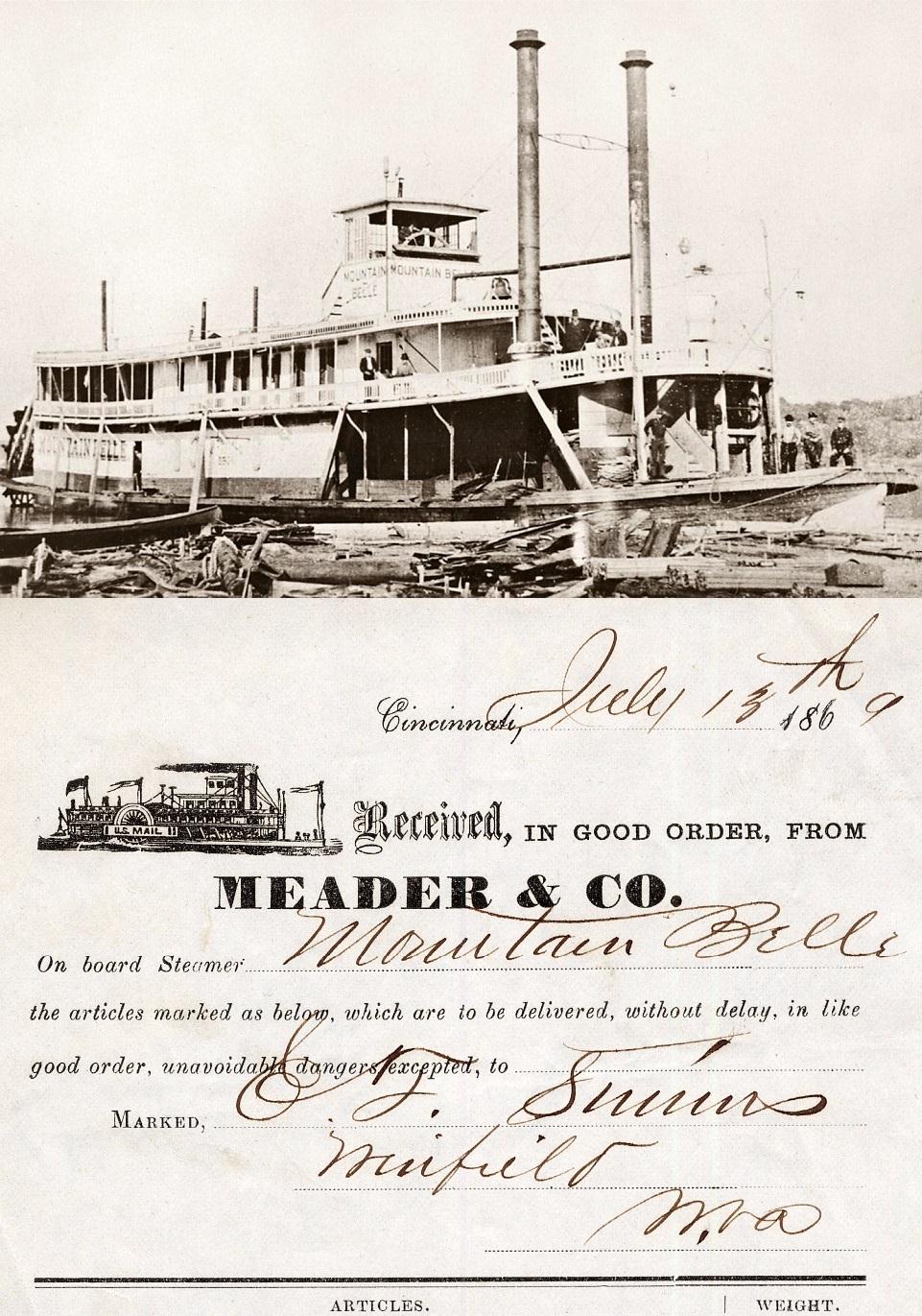
MOUNTAIN BELLE Packet/Rafter/Towboat
Way's Packet Directory - 4051 & Way's Steam Towboat Directory T1873
Built at Brownsville, Pennsylvania, 1869
Her machinery came from the Cottage No. 2. Captain McAllister ran her in the Portsmouth-Proctorville trade on the Ohio River.
Her first season she carried the payment for a farm known as Holderby's Landing, where Huntington, West Virginia is located today.
In January 1870 she became part of the Portsmouth & Big Sandy Packet Company, running Cincinnati-Portsmouth.
In March 1873 she was sold to the Upper Mississippi and converted into a rafter owned by Hewitt & Wood, La Crosse, Wisconsin.
Her subsequent owners, G.C. Hixson and the McDonald Brothers, also ran her in the Upper Mississippi rafting service.
She still was documented as a passenger vessel in 1876, probably for occasional excursion use, and inspected as a towboat in 1877.
She burned at La Crosse on February 5, 1877, with damage to her cabin and upper works.
She sank near Canton, Missouri, September 19, 1882.
In later years, E. C. Anthony, Hastings, Minnesota, bought her from the McDonald Brothers and renamed her The Purchase.
She ran as an excursion steamer, making frequent visits to Stillwater on the St. Croix and towing an excursion barge between St. Paul and the St. Louis World's Fair.
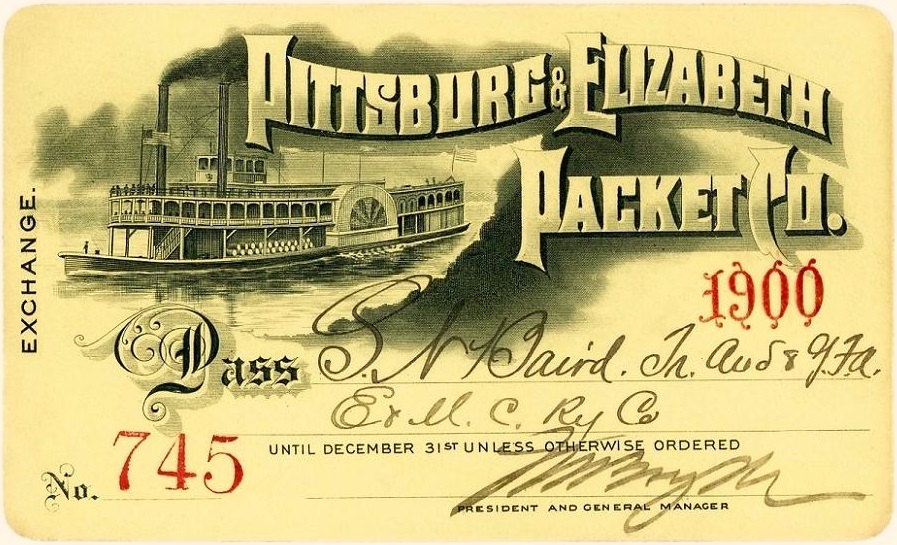
This Pittsburgh & Elizabeth Packet Company pass was issued in 1900.
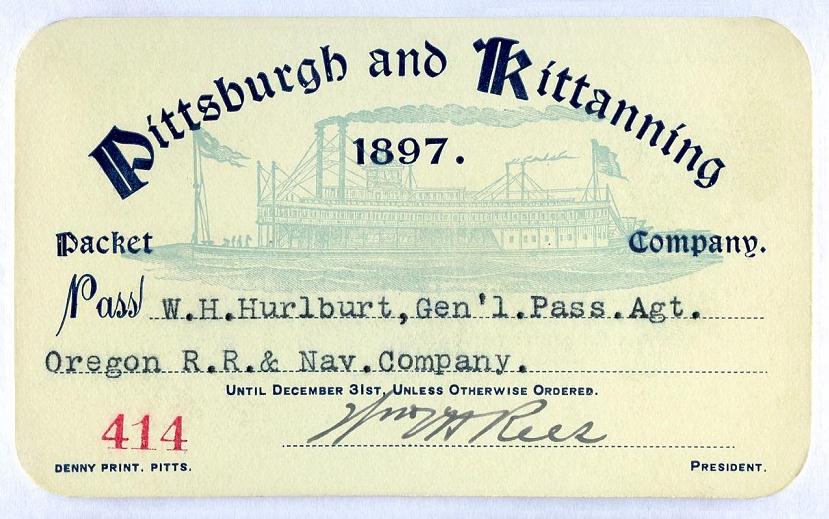
Have not found any specific boat so far that the Pittsburgh & Kittanning Packet Co. operated. Nothing in Way, Murphy or online. It's mysterious. Apparently their boats ran between Pittsburgh, PA on the Ohio River and Kittanning, PA, 44 miles northeast of Pittsburgh on the Allegheny River.
The pass was issued in 1897 and William M. Rees signed it. He was one of the stockholders in the BUCKEYE STATE that was built in 1878 and served as treasurer in James Rees & Sons Co. along with his brothers who held other offices administering the KATE ADAMS that was built in 1899.
In '42 Fred Way wrote The Allegheny for the Rivers of America series and it's on the shelf downstairs so I'll give it a "look-see."
More history is likely to surface in time.

Waybill from the JAMES REES dated November 6th, 1875
JAMES REES
Way's Packet Directory Number 2947
Sidewheel packet built 1862 at Elizabeth, Pennsylvania. 302 tons.
For the Pittsburgh & Elizabeth Packet Line she ran "as regular as clock work" until sold in September 1866 to Wheeling & Sun Fish Packet Co. which was owned by Capt. Steve Thompson and others.
Ran Wheeling-Clarington until she was dismantled in 1876 and her equipment used in building her successor, the TELEGRAM.
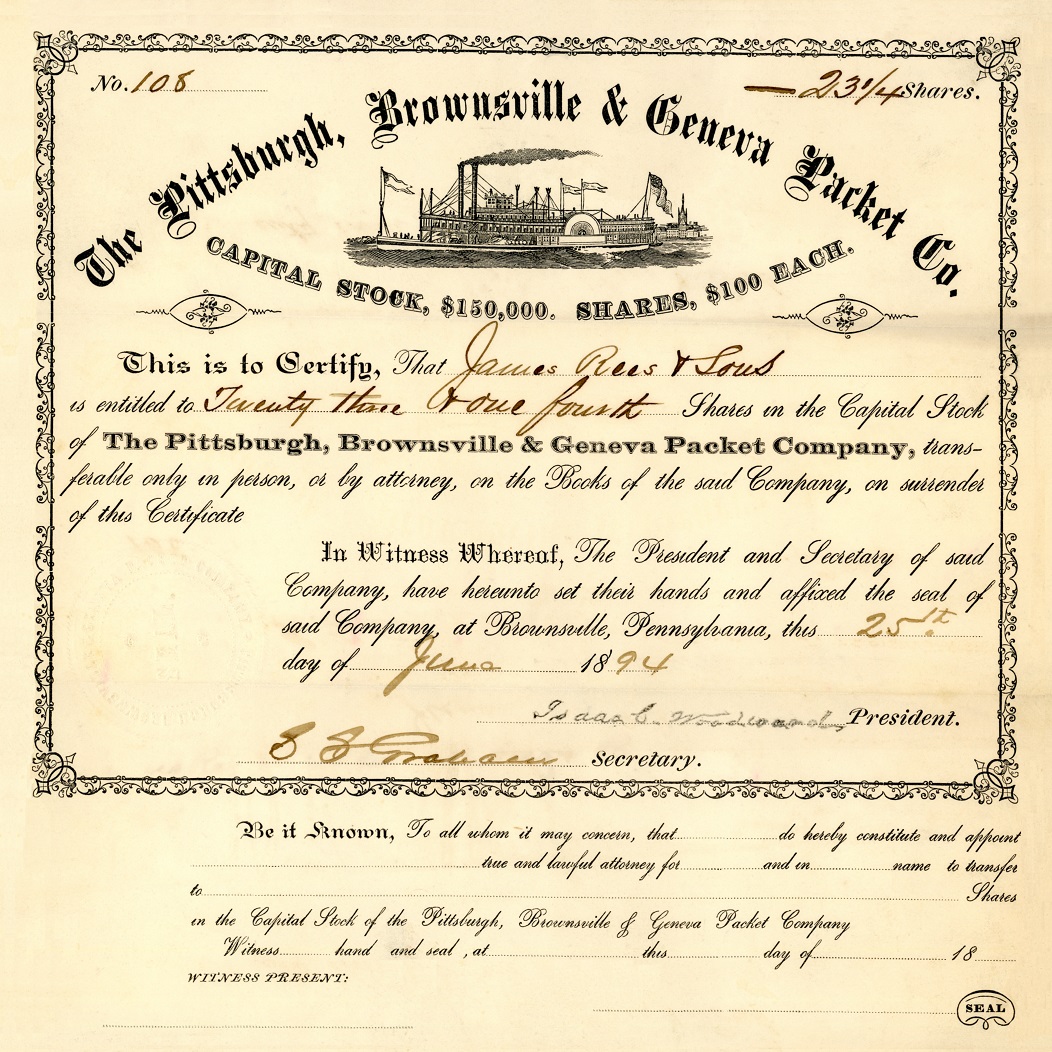
Stock Certificate Pittsburgh, Brownsville & Geneva Packet Co.
Stock Certificate for 23-1/4 shares in the Pittsburgh, Brownsville & Geneva Packet Co. to James Rees & Sons on 25th June 1894
Isaac C. Woodward President
S.S. Graham Secretary
Brownsville, Pennsylvania
(James Rees & Sons Co. of Pittsburgh installed machinery in a great many steamboats built along the Ohio River).
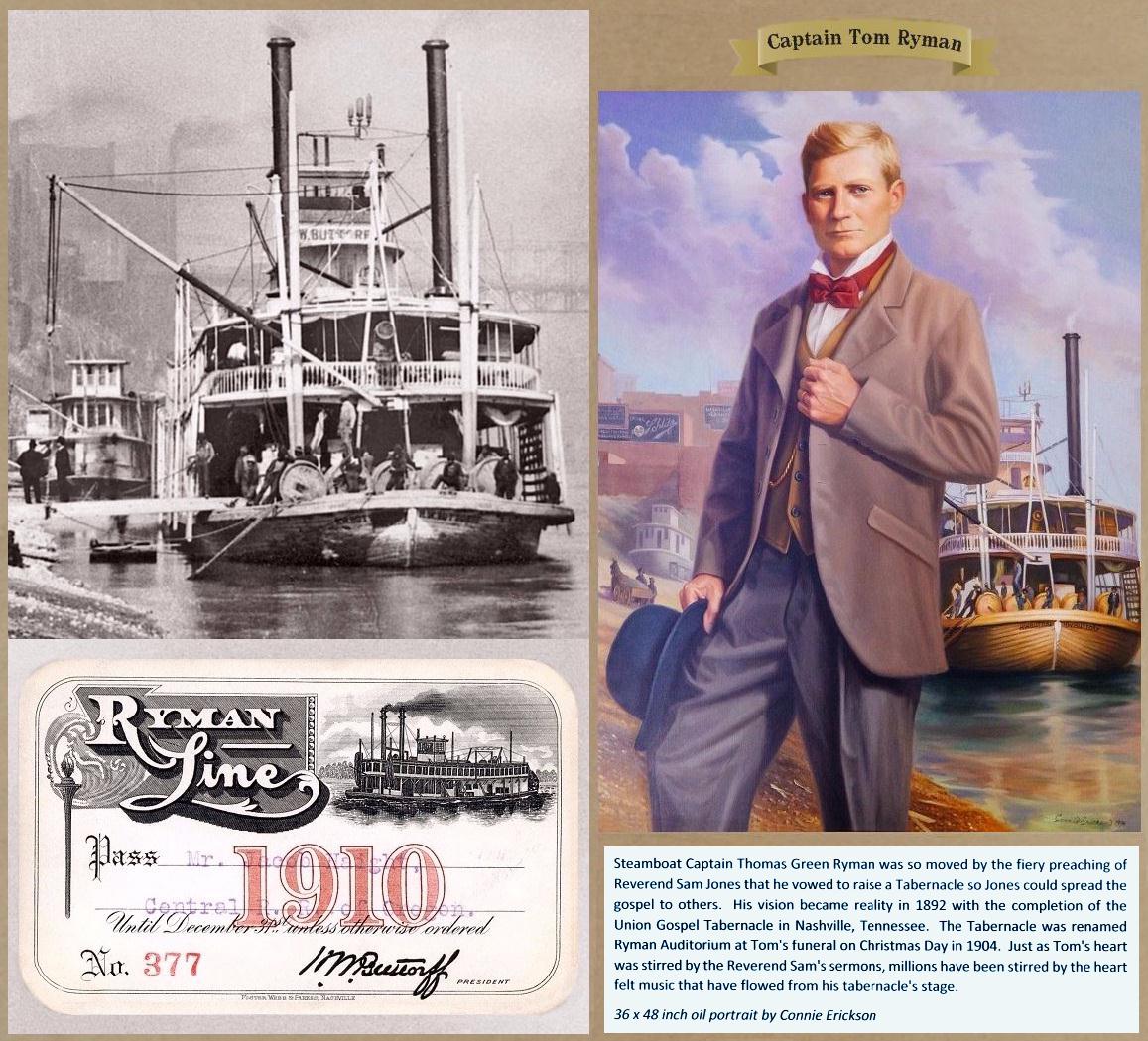
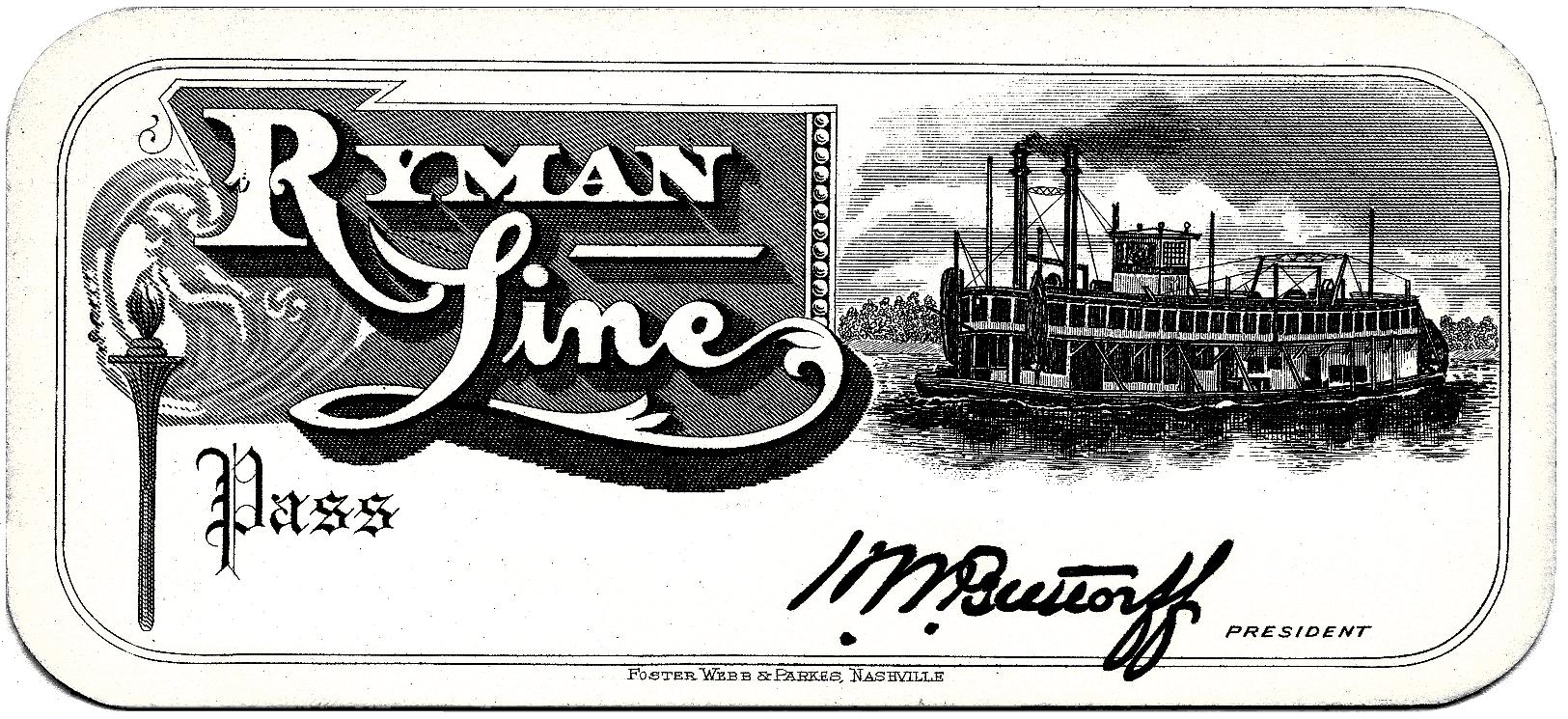
The Ryman Line was Captain Tom Ryman's company. In 1884 Tom "got religion" at one of Reverend Sam Jones' temperance revivals. Much like the New Moses, Jones preached against the "Demon Rum" and Captain Ryman decided to stop serving alcohol on his fleet of 35 steamboats. It cost Tom of course because passengers who loved to get liquored up at the bars on steamboats stopped booking passage on Tom's boats and instead traveled on boats that did served liquor. Captain Tom decided to build a venue in Nashville in which Reverend Jones could preach and as a result the Union Gospel Tabernacle was built over a span of 7 years and $100,000 and upon completion in 1892 the Reverend Jones gave his first sermon in that church. During his lifetime Captain Tom refused to allow the church to be renamed in his honor, but after his death in 1904 the congregation unanimously agreed to change the building's name to Ryman Auditorium which became the home of the Grand Ol' Opry in 1943.
I've had this 1910 Ryman Line pass for a long time and found a good application for it when I discovered a picture of Connie Erickson's 1994 portrait of Captain Tom then went to the Murphy site where I found the photo that Ms. Erickson used as reference for the background of the Nashville waterfront with the Ryman Line boat H.W. BUTTORFF at the wharf. I've placed the Ryman Line pass over the photo.
Way's Packet Directory Number 2509:
H.W. BUTTORFF Sternwheel Packet
Built 1896, Jeffersonville, Indiana by Howard Ship Yards
1896: Ryman Line; 1911: Lee Line
Operated on the Cumberland; Ohio and Mississippi rivers
The H.W. BUTTORFF was named for the founder of Phillips & Buttorff Company.
Original price, $7,000. She was involved in the Nashville-Paducah trade.
On March 5, 1899 she was blown against the stone piers of a bridge at Clarksville, Tennessee and sank.
Appeared to be a total loss, but was raised. Value at the time, $15,000.
Captain J.S. Tyner spent his honeymoon aboard, was master 15 years, and his wife lived aboard for eight of those years.
Under Captain Hunter on November 19, 1908, she was the first boat to jump a dam on the Cumberland. January 9, 1909, while en route down the Mississippi River near Plum Point, Tennessee, she struck a hidden obstruction causing floor timbers and bottom planking to break. Estimated damage, $500. On April 20, 1909 she collided with the J.B. Richardson on the Ohio River near Paducah, Kentucky, slightly damaging the Buttorff. Pilots on watch on both boats were found at fault. Harry L. Wills, the first class pilot on the BUTTORFF had his license suspended for 10 days by the steamship inspection service. The boat was purchased by the Lee Line in January 1911 and renamed JOHN LEE.
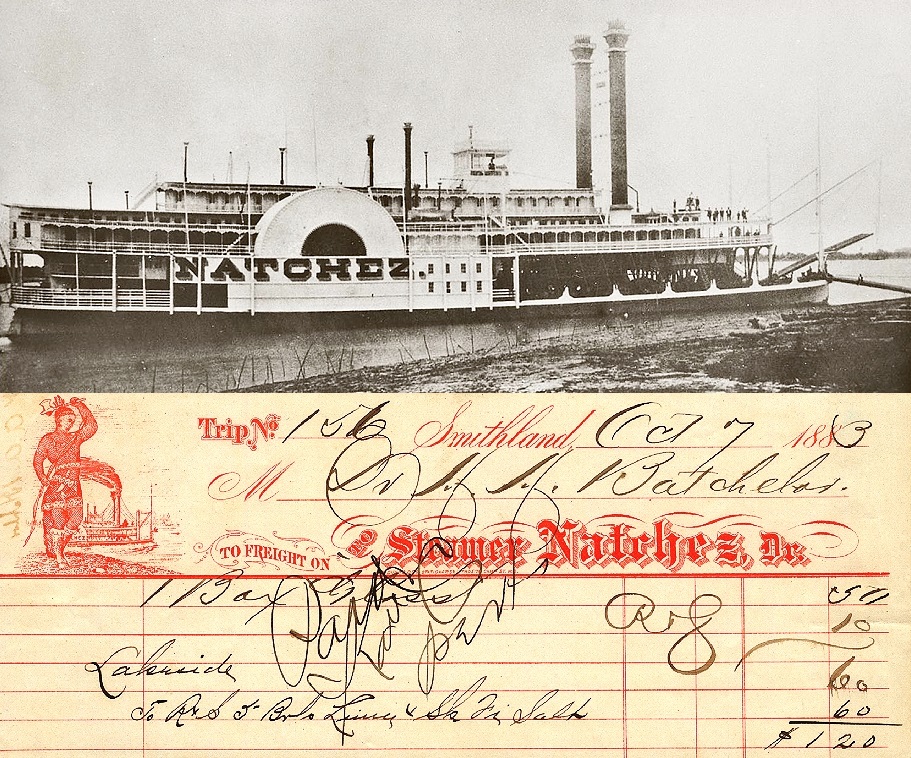
NATCHEZ 1879-1889
Sidewheel Packet
Way's Packet Directory Number 4110
The sixth of seven boats named NATCHEZ that were built for Captain Leathers.
The fifth NATCHEZ (1869-1879) was the boat that raced the ROB'T E. LEE in 1870.
This NATCHEZ the Sixth was built and assembled for Leathers in 1879 at Cincinnati, Ohio
A number of boat builders and artists were involved in the making of the boat:
1. The boilers, doctor, and chimneys were built by C.T. Dumont.
2. Her cylinder timbers were cut in Kentucky, hauled to the Big Sandy River and delivered to Cincinnati.
3. The iron work, including the stem band, was done in Pittsburgh.
4. Her cabin was built by Elias Ealer.
5. Coulter and Son in Cincinnati provided skylight glasses depicting 22 Indian portraits.
6. Semi-circular landscapes on the wheelhouses were done by artist Gordon Blentlinger.
7. Artist Dwight Bendon painted a scene at Natchez, Mississippi depicting Indians worshiping the rising sun on the forward skylight bulkhead in the cabin. On the aft bulkhead of the cabin Bendon painted a scene showing an Indian woman leaping from a bluff. (Probably from one of the many "Lover's Leaps" along the Mississippi River, including one at Hannibal, MO)
8. Robert McGregor painted the cabin interior scenes.
9. The architect for all seven of Captain Leather's NATCHEZ packets was Saunders Hartshorn.
The NATCHEZ was launched on Saturday, August 2, 1879.
The boat left Cincinnati towed by two Champions on September 9.
She went through the Louisville Canal to New Albany and then to Cairo.
On September 21, she left Cairo under her own steam for the south, arriving at New Orleans on September 29. As she came into view, a cloud of smoke was seen coming from her port side, amidships. Her cargo of cotton was on fire. 246 bales were lost as well as 38 sacks of seed.
When she finally landed, she received a royal reception. Captain Leathers was presented with a large hickory chair to commemorate the launching of the boat.
The NATCHEZ worked in the New Orleans-Vicksburg trade.
In May 1880 she took a large party of notables down to the Jetties.
On March 4, 1885 Captain Leathers a staunch Confederate partisan, who had not flown the American flag on any of his boats since 1860, decided to bury the hatchet and once again raised the flag. Beginning in 1887 the Natchez was tied up for a period of two years due to lack of business.
She was brought out to run to Greenville and sank at Stack Island in 1889. The sand washed out from under the hull and broke her up, but much of her cabin equipment was saved.
Pilot Jeff Hicks was on watch when the NATCHEZ sank and Hicks told Fred Way that he wept when he was told that he was a party to a total loss. "I felt greater pride piloting the NATCHEZ than any other boat."
Photo Courtesy of Murphy Library at the University of Wisconsin - La Crosse Steamboat Collection Photographs.
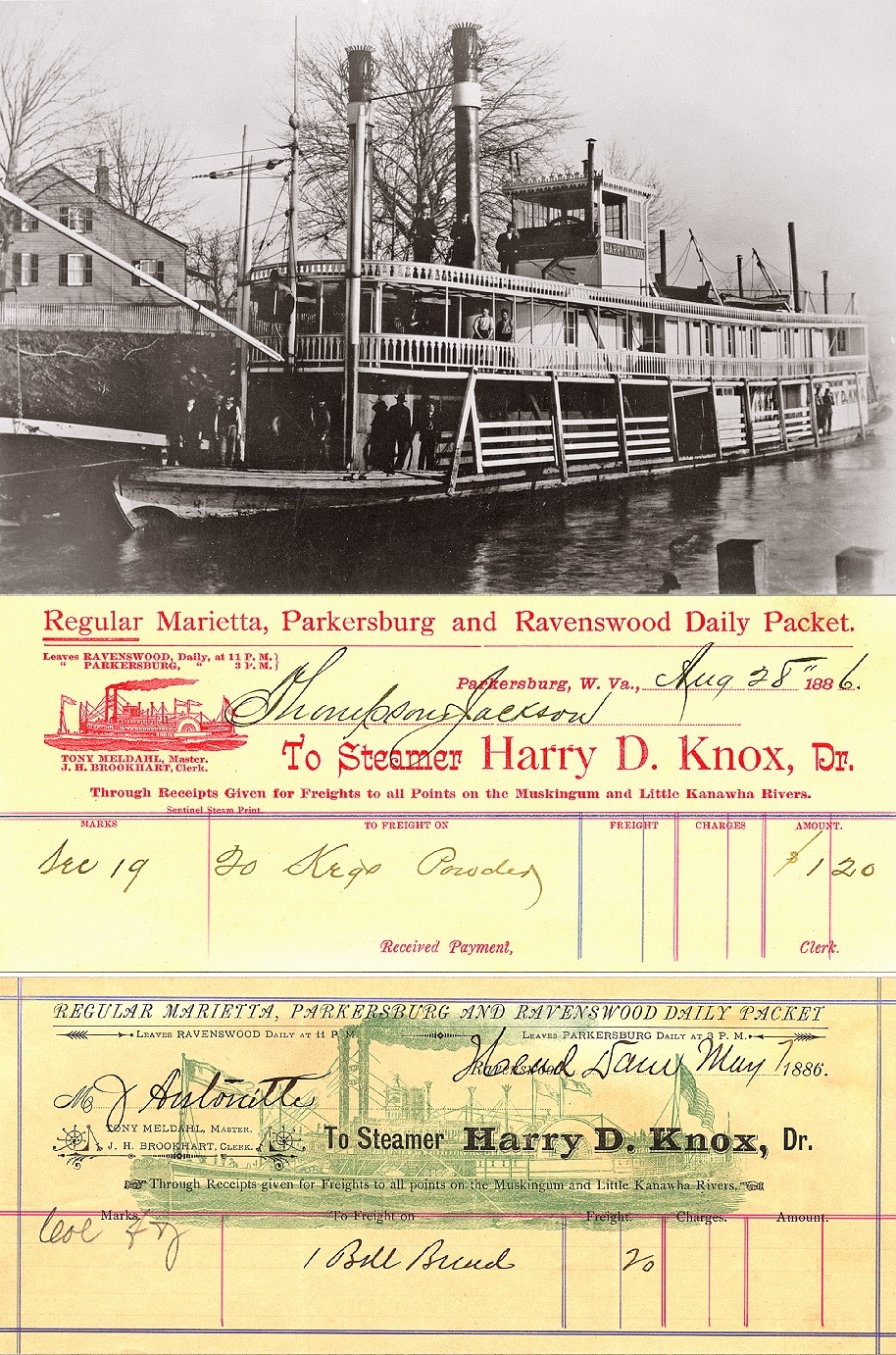
Steamboat Collection Photographs
HARRY D. KNOX (Sternwheel Packet, 1883-1898)
Way's Packet Directory Number 2536
Built 1883 at the Knox boatyard in Harmar, Ohio
Ran Marietta-Beverly on the Muskingum River her first two seasons.
Then ran Parkersburg-Belleville until the arrival of the B and O railroad.
After that she went into the Parkersburg-Ravenswood trade.
In 1894 she was sold to the Monongahela River, Charleroi-Rice's Landing trade in opposition to the Leni Leoti
Dismantled 1898
Owned by Captain O.J. Stowe; Wick Hayman; Lon Ritchie
Officers and Crew:
Captain Anthony (Tony) Meldahl (master, 1887)
Tom Monroe (clerk, 1887)
Captain J.E. Wilkinson (master, 1890)
R.W. Kelly (clerk, 1890)
Captain Charles Menges (master, 1894)
Photo Courtesy of Murphy Library at the University of Wisconsin - La Crosse Steamboat Collection Photographs.

With the exception of images credited to public institutions,
everything on this page is from a private collection.
Please contact Steamboats.com for permission for commercial use.*
All captions provided by Dave Thomson, Steamboats.com primary contributor and historian.
